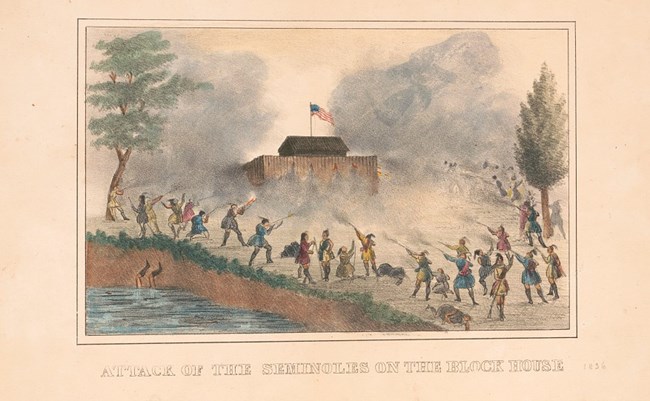Part of a series of articles titled 2023 Preservation Planning Grants Highlights.
Article
Spotlighting the Seminole Wars: New Investigations at Florida’s Micanopy Battlefield

Hand-colored lithograph by T.F. Gray and James, South Carolina, 1837. Image courtesy of the Library of Congress.
Recipient: Gulf Archaeology Research Institute
Amount: $131,450.00
For much of the 19th century, the Seminole people of northern Florida fought a series of violent conflicts against displacement known as the Seminole Wars. Formed from the merging of disparate Indigenous groups in the Southeast, the Seminole became a powerful Indigenous political and military force in the region by 1815. Parallel to this rise, the United States looked to its southern boarder as an area to expand after fighting the Red Stick Creek and the War of 1812, challenging Seminole autonomy. By 1821, the United States officially acquired Florida from the Kingdom of Spain and set about removing the territory’s Indigenous inhabitants so American settlers could claim the Seminole’s land for themselves.
Responding to these incursions, the Seminole organized armed resistance against American forces, attacking U.S. forts and settlements throughout Florida. The largest attack occurred on June 9, 1836, as 200 Seminole fighters led a coordinated assault against Fort Defiance in present-day Micanopy. Unlike their typical ambush-style tactics, the Seminole organized themselves into a line formation as they advanced on the Fort and attempted to surround it. Shocked by the swiftness of the Seminole attack, American forces fought desperately to hold their ground and only succeeded in breaking the Seminole line using cannon fire.
A tactical loss, the Seminole’s fierce opposition at Fort Defiance, and at other battlefields, slowed US military operations and prevented the total removal of all Seminole settlements to reservations west of the Mississippi River. Allowing hundreds of Seminoles to remain in Florida due to effective armed resistance.
A 2023 Preservation Planning Grant from the American Protection Program to the Gulf Archaeology Research Institute (GARI) will fund an archeological excavation at the Micanopy battlefield. GARI’s archeological research will develop new insights on how the Seminole used Micanopy’s terrain to their advantage during the battle. Using data recovered from the field, GARI will support the development of a National Register of Historic Places nomination for the battlefield.
Preservation Planning Grants are the American Battlefield Protection Program's broadest and most inclusive grant program, promoting the stewardship of battlefields and sites of armed conflict on American soil. In addition, ABPP administers three other grant opportunities: the Battlefield Land Acquisition Grant, Battlefield Restoration Grant, and Battlefield Interpretation Grant programs. This financial assistance generates community-driven stewardship of historic resources at the state, tribal and local levels.
Get Your Project Funded
Check out the American Battlefield Protection Program's website for more information about various grant offerings and eligibility.
Last updated: August 7, 2023
